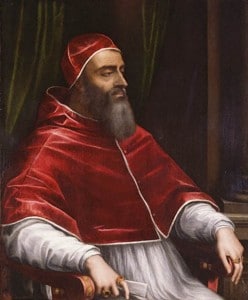
On 11th July 1533, just over a month after Anne Boleyn’s coronation, Pope Clement VII declared that Henry VIII’s marriage to Anne Boleyn was null, as was the annulment of his marriage to Catherine of Aragon, and threatened the King with excommunication if he did not abandon the pregnant Anne and return to Catherine.
The Pope stated that he was suspending the declaration of the sentence of excommunication until September 1533, so that Henry would have time to make all the arrangements. Henry ignored the Pope’s declaration but was not excommunicated until 17th December 1538, after he had upset Pope Paul III by declaring himself head of the church in England, by persecuting those who did not accept his supremacy, by dissolving the monasteries, and by his brutal actions in the Pilgrimace of Grace rebellion. The final straw for the papacy in 1538 was Henry’s attack on religious shrines in England, which included him having “dug up and burned the bones of St, Thomas of Canterbury and scattered the ashes to the winds, (after calling the saint to judgment, condemning him as contumacious, and proclaiming him a traitor).”
Of course, although Henry VIII never returned to Catherine of Aragon, he had his marriage to Anne Boleyn annulled shortly before she was executed in May 1536.
Notes and Sources
- LP vi. 807, 808
- LP xiii. Part 2. 1087